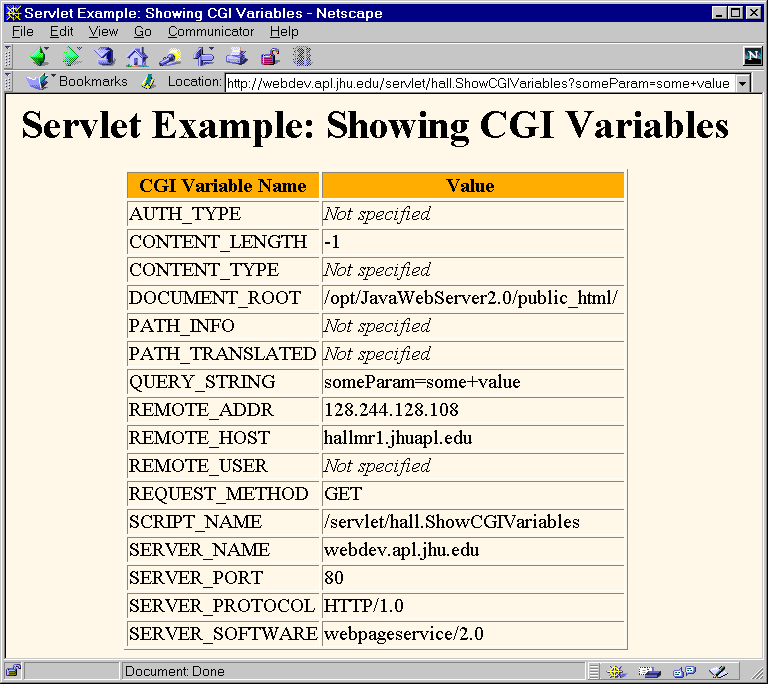| Accessing the Standard CGI Variables |
|---|
|
1. Introduction to CGI Variables
If you come to Java servlets from traditional CGI, you are probably used to the idea of "CGI Variables". These are a somewhat eclectic collection of information about the request. Some are derived from the HTTP request line and headers (e.g. the part of the URI that came after the question mark and typically contains the form data, or theContent-Length header), some are derived from the
socket itself (e.g. the name and IP address of the requesting host), and some
are derived from server installation parameters (e.g. the mapping of URLs to
actual paths).
2. Servlet Equivalent of Standard CGI Variables
Although it probably makes more sense to think of different sources of data (request data, server data, etc.) as distinct, experienced CGI programmers may find the following table useful. Assume thatrequest is the HttpServletRequest supplied to the
doGet and doPost methods.
| CGI Variable | Meaning | Accessing it from doGet or doPost |
|---|---|---|
AUTH_TYPE
| If an Authorization header was supplied, this is the
scheme specified (basic or digest)
| request.getAuthType()
|
CONTENT_LENGTH
| For POST requests only, the number of bytes of data sent.
| Technically, the equivalent is
String.valueOf(request.getContentLength()) (a
String) but you'll probably want to just call
request.getContentLength(), which returns an
int.
|
CONTENT_TYPE
| MIME type of attached data, if specified. | request.getContentType()
|
DOCUMENT_ROOT
| Path to directory corresponding to http://host/ | getServletContext().getRealPath("/") Note that this was
request.getRealPath("/") in older servlet specifications.
|
HTTP_XXX_YYY
| Access to arbitrary HTTP headers | request.getHeader("Xxx-Yyy")
|
PATH_INFO
| Path information attached to the URL. Since servlets, unlike standard CGI programs, can talk to the server, they don't need to treat this separately. Path info could be sent as part of the regular form data. | request.getPathInfo()
|
PATH_TRANSLATED
| The path information mapped to a real path on the server. Again, with servlets there is no need to have a special case for this. | request.getPathTranslated()
|
QUERY_STRING
| For GET requests, this is the attached data as one big
string, with values still URL-encoded. You rarely want the raw data in
servlets; instead use request.getParameter to access
individual parameters.
| request.getQueryString()
|
REMOTE_ADDR
| The IP address of the client that made the request, as a String. E.g.
"192.9.48.9".
| request.getRemoteAddr()
|
REMOTE_HOST
| The fully qualified domain name (e.g. "java.sun.com") of
the client that made the request. The IP address is returned if this
cannot be determined.
| request.getRemoteHost()
|
REMOTE_USER
| If an Authorization header was supplied, the user part.
| request.getRemoteUser()
|
REQUEST_METHOD
| The request type, which is usually GET or
POST, but is occasionally HEAD,
PUT, DELETE, OPTIONS, or
TRACE.
| request.getMethod()
|
SCRIPT_NAME
| Path to servlet. | request.getServletPath()
|
SERVER_NAME
| Web server's name | request.getServerName()
|
SERVER_PORT
| Port server is listening on. | Technically, the equivalent is
String.valueOf(request.getServerPort()), which returns a
String. You'll usually just want
request.getServerPort(), which returns an int.
|
SERVER_PROTOCOL
| Name and version used in the request line (e.g. HTTP/1.0
or HTTP/1.1).
| request.getProtocol()
|
SERVER_SOFTWARE
| Identifying information about the Web server | getServletContext().getServerInfo() |
3. Example: Reading the CGI Variables
Here's a servlet that creates a table showing the values of all the CGI variables other thanHTTP_XXX_YYY, which are just the HTTP request headers shown in
the previous section.
3.1 ShowCGIVariables.java
Note: also uses ServletUtilities.java, shown earlier.package hall; import java.io.*; import javax.servlet.*; import javax.servlet.http.*; import java.util.*; /** Creates a table showing the values of all the CGI variables. ** Part of tutorial on servlets and JSP that appears at * http://www.apl.jhu.edu/~hall/java/Servlet-Tutorial/ * 1999 Marty Hall; may be freely used or adapted. */ public class ShowCGIVariables extends HttpServlet { public void doGet(HttpServletRequest request, HttpServletResponse response) throws ServletException, IOException { response.setContentType("text/html"); PrintWriter out = response.getWriter(); String[][] variables = { { "AUTH_TYPE", request.getAuthType() }, { "CONTENT_LENGTH", String.valueOf(request.getContentLength()) }, { "CONTENT_TYPE", request.getContentType() }, { "DOCUMENT_ROOT", getServletContext().getRealPath("/") }, { "PATH_INFO", request.getPathInfo() }, { "PATH_TRANSLATED", request.getPathTranslated() }, { "QUERY_STRING", request.getQueryString() }, { "REMOTE_ADDR", request.getRemoteAddr() }, { "REMOTE_HOST", request.getRemoteHost() }, { "REMOTE_USER", request.getRemoteUser() }, { "REQUEST_METHOD", request.getMethod() }, { "SCRIPT_NAME", request.getServletPath() }, { "SERVER_NAME", request.getServerName() }, { "SERVER_PORT", String.valueOf(request.getServerPort()) }, { "SERVER_PROTOCOL", request.getProtocol() }, { "SERVER_SOFTWARE", getServletContext().getServerInfo() } }; String title = "Servlet Example: Showing CGI Variables"; out.println(ServletUtilities.headWithTitle(title) + "<BODY BGCOLOR=\"#FDF5E6\">\n" + "<H1 ALIGN=CENTER>" + title + "</H1>\n" + "<TABLE BORDER=1 ALIGN=CENTER>\n" + "<TR BGCOLOR=\"#FFAD00\">\n" + "<TH>CGI Variable Name<TH>Value"); for(int i=0; i<variables.length; i++) { String varName = variables[i][0]; String varValue = variables[i][1]; if (varValue == null) varValue = "<I>Not specified</I>"; out.println("<TR><TD>" + varName + "<TD>" + varValue); } out.println("</TABLE></BODY></HTML>"); } public void doPost(HttpServletRequest request, HttpServletResponse response) throws ServletException, IOException { doGet(request, response); } }
3.2 ShowCGIVariables Output
